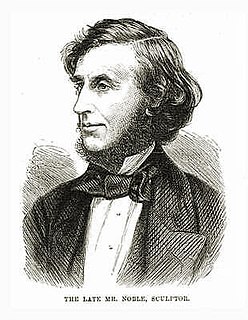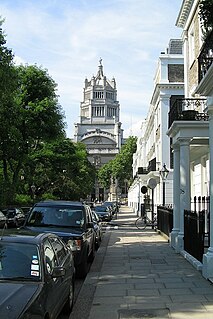
Kensington is an affluent district in the Royal Borough of Kensington and Chelsea in the West of Central London.

Hyde Park is a Grade I-listed major park in Central London. It is the largest of four Royal Parks that form a chain from the entrance of Kensington Palace through Kensington Gardens and Hyde Park, via Hyde Park Corner and Green Park past the main entrance to Buckingham Palace. The park is divided by the Serpentine and the Long Water lakes.

Kensington Gardens, once the private gardens of Kensington Palace, are among the Royal Parks of London. The gardens are shared by the City of Westminster and the Royal Borough of Kensington and Chelsea and sit immediately to the west of Hyde Park, in western central London. The gardens cover an area of 107 hectares. The open spaces of Kensington Gardens, Hyde Park, Green Park, and St. James's Park together form an almost continuous "green lung" in the heart of London. Kensington Gardens are Grade I listed on the Register of Historic Parks and Gardens.

John Thurloe was an English politician who served as secretary to the council of state in Protectorate England and spymaster for Oliver Cromwell. He was from Great Milton in Oxfordshire and of Lincoln's Inn,
Earl's Court is a district of Kensington in the Royal Borough of Kensington and Chelsea in West London, bordering the rail tracks of the West London line and District line that separate it from the ancient borough of Fulham to the west, the sub-districts of South Kensington to the east, Chelsea to the south and Kensington to the northeast. It lent its name to the now defunct eponymous pleasure grounds opened in 1887 followed by the pre–World War II Earls Court Exhibition Centre, as one of the country's largest indoor arenas and a popular concert venue, until its closure in 2014. The area has long been known as "Bedsitter Land" with many of its stuccoed terraces converted into studio flats, hotels and hostels.

Cromwell Road is a major London road in the Royal Borough of Kensington and Chelsea, designated as part of the A4. It was created in the 19th century and is said to be named after Richard Cromwell, son of Oliver Cromwell, who once owned a house there.

South Kensington is a district just west of Central London in the Royal Borough of Kensington and Chelsea. Historically it settled on part of the scattered Middlesex village of Brompton. Its name was supplanted with the advent of the railways in the late 19th century and the opening and naming of local tube stations. The area is known as a popular tourist destination owing to the density of museums and cultural landmarks. Adjacent affluent centres such as Knightsbridge, Chelsea and Kensington, have been considered as some of the most exclusive real estate in the world. Since the First World War it has become a cosmopolitan area attracting Belgian and French refugees, but also Poles during the Second World War and after, and latterly Spanish, Italian, American, and Middle-Eastern expatriates. The French presence is emphasised by the Lycée Français Charles de Gaulle, the French Institute, hosting the Ciné Lumière a window on French cinema and the Alliance française and the French consulate, among other diplomatic residences. With a French bookshop and many international cafés in the area, it has been called Paris’s 21st arrondissement.
The Royal Borough of Kensington and Chelsea, an Inner London borough, has responsibility for some of the parks and open spaces within its boundaries. Most of them are relatively small: many are the typical London square, built to service the houses around that square. Two of the larger open spaces both form part of the "Magnificent Seven" cemeteries, being those at Brompton and Kensal Green. The parks are policed by the Royal Borough of Kensington and Chelsea Parks Police.
Brompton, sometimes called Old Brompton, survives in name as a ward in the Royal Borough of Kensington and Chelsea in London. Until the latter half of the 19th century it was a scattered village made up mostly of market gardens in the county of Middlesex. It lay south-east of the village of Kensington, abutting the parish of St Margaret's, Westminster at the hamlet of Knightsbridge to the north-east, with Little Chelsea to the south. It was bisected by the Fulham Turnpike, the main road westward out of London to the ancient parish of Fulham and on to Putney and Surrey. It saw its first parish church, Holy Trinity Brompton, only in 1829. Today the village has been comprehensively eclipsed by segmentation due principally to railway development culminating in London Underground lines, and its imposition of station names, including Knightsbridge, South Kensington and Gloucester Road as the names of stops during accelerated urbanisation, but lacking any cogent reference to local history and usage or distinctions from neighbouring settlements.

Exhibition Road is a street in South Kensington, London which is home to several major museums and academic establishments, including the Victoria and Albert Museum, the Science Museum and the Natural History Museum.

Cromwell Gardens is a short but major road in South Kensington, within the Royal Borough of Kensington and Chelsea, London, England. It joins the Cromwell Road at the junction with Exhibition Road to the west with the Brompton Road to the east.

Matthew Noble was a leading British portrait sculptor. Carver of numerous monumental figures and busts including work memorializing Victorian era royalty and statesmen displayed in locations such as Westminster Abbey, St. Paul's Cathedral and in Parliament Square, London.

Squares have long been a feature of London and come in numerous identifiable forms. The landscaping spectrum of squares stretches from those with more hardscape, constituting town squares —to those with communal gardens, for which London is a major international exponent, known as garden squares.

Thurloe Square is a traditional garden square in South Kensington, London, England.

The Ismaili Centre, London is one of six such centres world-wide. Established in South Kensington more than thirty years ago, it is a religious, social and cultural meeting place for the Ismaili Muslim community in the United Kingdom and is the first such centre to be specially designed and built for Ismailis in the Western world.

Ladbroke Square is a garden square in Notting Hill, west London, England.

Gunnersbury Cemetery, also known as Kensington or New Kensington Cemetery, is a cemetery opened in 1929. Although it is owned and managed by the Royal Borough of Kensington and Chelsea, it is geographically located within the London Borough of Hounslow, at 143 Gunnersbury Avenue in Acton.
Angela Conner FRBS is an English sculptor who works in London. Conner has exhibited internationally and has large scale sculptures in public and private collections around the world.
Frank P. LoCicero Triangle is a 250-square-foot (23 m2) triangular public green space located in the Bellerose neighborhood of Queens, New York. It is named in honor of local resident Frank P. LoCicero (1918-1997) who lived in the area from 1950 until his death. In the years between, LoCicero was an active member and later president of the Bellerose Hillside Civic Association, which fought to maintain the suburban character of the neighborhood.

Twelve Responses to Tragedy, or the Yalta Memorial, is a memorial located in the Yalta Memorial Garden on Cromwell Road in South Kensington in west London. The memorial commemorates people displaced as a result of the Yalta Conference at the conclusion of the Second World War. Created by the British sculptor Angela Conner, the work consists of twelve bronze busts atop a stone base. The memorial was dedicated in 1986 to replace a previous memorial from 1982 that had been repeatedly damaged by vandalism.
















